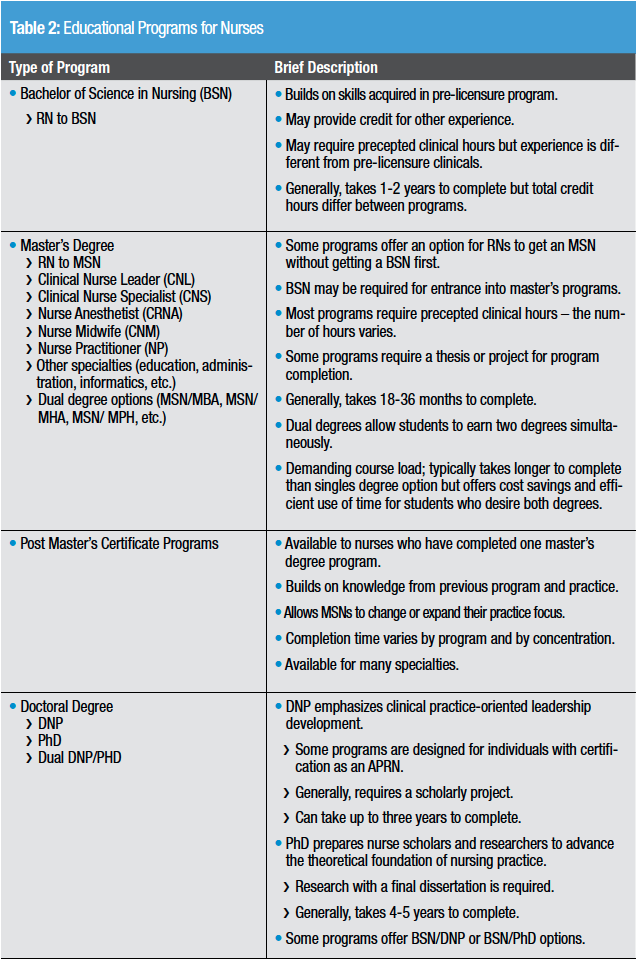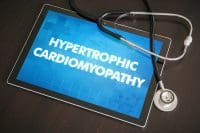Introduction
Are you thinking about continuing your education in nursing? Nurses play a pivotal role in meeting the demands of a rapidly changing healthcare system. With nurses leading change efforts to advance health and an increasing focus on competency, many nurses are contemplating their education and their opportunities in nursing. There are several different types of programs available. This article provides a brief overview of program types and describes factors to consider when choosing the educational program to best meet the individual’s needs.
As patient complexity has increased over the past several decades, so has the efforts to increase the number of baccalaureate, masters, and doctorally prepared nurses. The Institute of Medicine (IOM) issued a report, The Future of Nursing: Leading Change, Advancing Health, which included eight recommendations as a call to action for the nursing professions (IOM, 2011). Recommendation four was to increase the proportion of nurses with a Bachelor of Science in Nursing (BSN) to 80% by 2020, and recommendation five was to double the number of nurses with a doctorate by 2020.
The IOM report recommended that academic nurse leaders, with support from private and public founders, academic administrators and trustees, accrediting bodies and health care organizations, work to:
- Increase the number of BSN-prepared nurses,
- Increase the diversity of students to create a workforce prepared to meet the demands of diverse populations across the lifespan, and
- Add to the cadre of nurse faculty and researchers with a doctorate degree (IOM, 2011).
Another IOM recommendation was to ensure that nurses engage in lifelong learning. The importance of this in maintaining the competencies needed to provide care for diverse populations across the lifespan is critical. The report recommended that accrediting bodies, nursing programs, health care organizations, and professional development educators from multiple professions collaborate to ensure that nurses, nursing students, and faculty continue their education and engage in lifelong learning.
The National Academies of Sciences, Engineering, and Medicine (2016) issued a report on the progress towards the 2010 goals. The number of en-try-level baccalaureate programs increased from 641 in 2010 to 704 in 2014, and the number of accelerated baccalaureate programs increased from 233 to 299. Enrollment in pre-licensure baccalaureate programs, including entry-level and accelerated baccalaureate programs, increased by 17 percent, from 161,540 to 189,729 students, during this period.
Since The Future of Nursing was released, enrollment in doctoral programs has risen. Enrollment in Doctor of Nursing Practice (DNP) programs has grown rapidly, while enrollment in Doctor of Philosophy (PhD) programs has grown at a slower rate. Since fall 2010, enrollment in DNP programs has more than doubled, from 7,034 to 18,352 students (a 161 percent increase). Meanwhile, enrollment in PhD programs has increased by 15 percent during this period, with 5,290 students pursuing a research-focused doctorate (National Academies of Sciences, Engineering, and Medicine, 2016).
The COVID pandemic and economic uncertainty post-pandemic negatively impacted nursing education program enrollments. An annual survey of 974 institutions, conducted by the American Association of Colleges of Nursing (AACN), revealed a decrease in nursing program enrollments for the first time in recent history (AACN, 2023). The number of nurses pursuing RN-BSN education decreased by 16.9% (19,871 students); In Master of Science in Nursing (MSN) and Doctoral-level education, the drop in enrollment was smaller with 9.4% or 13,695 fewer master’s students and 4.1% or 183 fewer doctoral students. The exception to this trend was enrollment in DNP programs, which increased by 0.6% (242 students).
It should be noted that the decade ahead will test the nation’s over 5 million registered nurses in new and complex ways. Nurses live and work at the intersection of health, education, and communities. Further, nurses work in a wide array of settings and practice at a range of professional levels. They are often the first and most frequent line of contact with people of all backgrounds and experiences seeking care, and they represent the largest of the healthcare professions.
The Future of Nursing 2020-2030: Charting a Path to Achieve Health Equity (National Academies of Sciences, Engineering, and Medicine, 2021) explored how nurses can work to reduce health disparities and promote equity, while keeping costs at bay, utilizing technology, and maintaining patient and faculty-focused care into 2030. This work builds on the foundation set out by The Future of Nursing: Leading Change, Advancing Health (2011) report.
Although the recommendations in the 2020-2030 report focus on health equity, there are several areas relating to education and continued competence. Nurses consistently incorporate a health equity lens learned through revamped academic and continuing education. Nurses focus on preventive per-son-centered care and have an orientation toward innovation, always seeking new opportunities for growth and development. They expand their roles, work in new settings and in new ways, and markedly expand their partnerships connecting health and health care with all individuals and communities (National Academies of Sciences, Engineering, and Medicine. 2021).
Identifying Career Goals
The first step when considering a post-licensure nursing program is to look at your career goals. Table 1 provides some questions that may help you with this first step. Achieving your goals may require more than one educational program, but planning can save you time and resources to get to the goal. See Table 1
Table 1: Questions to Clarify your Career Goals
- What role do you want to have in five or ten years from now?
- What is the preparation required for that role?
- If you want to become an Advanced Practice Registered Nurse (APRN), are you interested in becoming a clinical nurse specialist, a nurse practitioner, a nurse anesthetist, or a nurse midwife?
- Are there specific populations or health issues you would like to impact?
- Are you interested in conducting research?
- Which program can help you achieve your goal?
Identifying type of program
There are various post-licensure options available to nurses seeking to continue their education. Most program types are offered in traditional, online, and blended delivery format. A chart describing the most common options is provided in Table 2.

Factors to Consider
Online Versus Traditional
Arms (2013) outlined considerations for choosing an online program. First you must examine how you learn. If you like the traditional classroom, with faculty lecturing and the interactions with other students, the online environment might not be for you. Many nurses see online learning as easier than learning in the traditional classroom. However, students spend just as much time in front of a computer as they would in the classroom. In addition, some computer literacy is required for online learning. Online programs typically use synchronous
(real-time discussions) and asynchronous (discussion posts at your convenience) activities. It should be noted that even programs offering traditional class-room learning frequently incorporate online learning activities. The online environment offers an opportunity to study at your convenience in the comfort of your own home. Though flexible in scheduling, online learning does require self-motivation and discipline. Regularly scheduled times for completing assignments and interaction in the online environment are key elements in student engagement and student success (Smith et.al, 2021).
According to Reeves (2020), the top challenges students reported in choosing an online program included (in order of importance):
- Estimating actual costs (tuition, books, etc.).
- Applying for financial aid and identifying sufficient funding sources.
- Finding a program that “meets my needs and interests.”
- Finding sufficient information about academic requirements.
- Contacting a real person to ask detailed questions about specific programs.
The Association for Nursing Professional Development (ANPD) published a discussion paper on nursing professional development (NPD) practitioner re-sponsibility in advising for academic advancement (ANPD, 2017). NPD practitioners are often consulted by individuals wishing to pursue their education. Any nurse giving advice to others about education programs should be aware of the following.
1. The American Association of Colleges of Nursing (AACN) published The Essentials: Core Competencies for Professional Nursing Education (AACN, 2021). Used to define quality in nursing education, the AACN Essentials outline the necessary curriculum content and expected competencies of graduates from baccalau-reate, master’s, and Doctor of Nursing Practice programs. Educational programs should be applying these guidelines into their curriculum.
2. Perceived barriers nurses must overcome to further their academic advance include receiving mixed messages from employers regarding support for return to school, a lack of vision of what can be gained by an advanced degree, and minimal salary increases with advanced degrees. Common barriers including costs and schedule may be overcome with tuition reimbursement, flexible work arrangements, and professional advancement. Other considerations include work schedule, format of classes (online, traditional, or blended), application processes, technology for online learning, and lack of practice/academic partnerships (ANPD, 2017).
3. When choosing a program, the nurse should be encouraged to explore scholarships, tuition discounts, schedule adjustments, and the availability of preceptors for clinical experiences.
Accreditation
The two recognized accrediting bodies for nursing programs are the Commission of Collegiate Nursing Education (CCNE) and the Accreditation Commission for Education in Nursing (ACEN). These bodies review policies, curriculum, financial standing, and instructors to ensure they meet basic requirements. Nursing programs should be accredited or seeking accreditation by one of these groups. In addition, the college/university should be accredited by a regional accreditation body.
Program Costs and Financial Aid
Costs and the number of courses required vary dramatically between educational programs. In addition to tuition costs, many programs impose educational fees. Consideration should also be given to necessary purchases, such as a computer, software, and textbooks. Since paying for education can be challenging, exploring the available financial aid is another important consideration. Understanding what is available will help you understand how much you will need to pay out-of-pocket. You should also explore what financial assistance your employee provides. Some organizations have agreements with schools for a discounted rate for employees while others have educational assistance programs to help cover portions of the tuition. Be aware that failure to meet the requirements of the organization to receive the tuition assistance may result in a need to pay back the funds. Several professional associations and foundations offer scholarships and grants for nursing education. The granting organization or foundation defines the criteria for these awards. For example, the funder may require the nurse to enroll in a certain type of nursing education program or be a member of the funding organization.
Clinical Experiences
The amount of clinical time required (if any) and the process for clinical placement should be considered. Are clinical placements varied enough to provide sufficient hands-on experience? Does the school assist with clinical placements, or does the student need to find his/her own preceptor? How strong is the program’s affiliation with clinics and hospitals? Are there opportunities in your immediate area for the specialty you selected? A clinical affiliation agreement is required for students to have clinical experiences in a facility. Remember to ask potential sites if they have an agreement in place or would be willing to create an agreement. Because clinical experiences are a required element of APRN education, answers to these questions are important to consider when selecting a program.
Specialties
Post-licensure BSN programs typically do not offer specialty concentration. However, in graduate programs, students need to select a track or area of con-centration. Your career goal will determine the specialty in which you are interested. You can then decide on a nursing program that matches your goal. Nursing specialties require an advanced nursing degree from an accredited institution. If you are interested in a graduate program requiring certification to practice in that role, look at the pass rate for the APRN certification exam.
Qualifications of Faculty
The credentials of the faculty are another consideration. What experience do they have in the area they are teaching? Most university websites have a list of faculty members for each program. In Ohio, faculty supervising undergraduate students in the clinical area must have a minimum of a BSN, and a Master’s degree is preferred. Many schools require a minimum of a master’s degree with a doctoral degree preferred for teaching faculty. It may be difficult to as-certain a faculty member’s expertise with online education, if that is the route you want to go, but many websites have student testimonials, or you can check with students who have attended a particular program to get their feedback.
Available Resources
It is important to identify what resources are available for students. Students in online programs should have the same access to faculty, services, and re-sources as with traditional programs. Students should have ample means of communication with faculty and staff. Are technology and library services avail-able to students? Does the program offer student advising and other student services to promote student success? Basic computer literacy is required to work within an online environment, but you need to look at what technical resources are available with online programs if you have difficulty accessing course information.
Admission Tests
Generally, admission tests are not required for RN to BSN programs, but they may be required for entrance into masters or graduate programs. The Gradu-ate Record Examination (GRE) is a broad assessment of critical thinking, analytical writing, verbal reasoning, and quantitative reasoning skills. The GRE re-vised General Test is the most widely accepted graduate admissions test worldwide and provides a common measure for comparing candidates. In the graduate school admission process, the level of emphasis that is place upon GRE scores varies widely among schools and between departments within schools. The importance of a GRE score can range from being a mere admission formality to an important selection factor.
Conclusion
Deciding to continue your education is an important decision which needs to be made after thoughtful consideration. It is important to find the program that provides the educational foundation for you to achieve your career goals. This article has outlined some of the factors to consider when selecting a nursing program. Additional resources for students from the American Association of Colleges of Nursing can be found at: https://www.aacnnursing.org/.
References
American Association of Colleges of Nursing. (2023). Enrollment and graduations in baccalaureate and graduate programs in nursing 2022-2023. American Association of Colleges of Nursing.
American Association of Colleges of Nursing. (2021). The essentials: Core competencies for professional nursing education. https://www.aacnnursing.org/Portals/0/PDFs/Publications/Essentials-2021.pdf
Arms, D. (2013). Getting your degree online: Is it right for you? Ohio Nurses Review, 88(1), 12.
Association for Nursing Professional Development. (2017). ANPD discussion paper: Nursing professional development (NPD) practitioner responsibility in advising for academic advancement. Association for Nursing Professional Development.
Institute of Medicine of the National Academies. (2011). The future of nursing: Leading change, advancing health. https://nap.nationalacademies.org/catalog/12956/the-future-of-nursing-leading-change-advancing-health
National Academies of Sciences, Engineering, and Medicine. (2016). Assessing progress on the Institute of Medicine report the future of nursing. The Na-tional Academies Press. https://nap.nationalacademies.org/catalog/21838/assessing-progress-on-the-institute-of-medicine-report-the-future-of-nursing
National Academies of Sciences, Engineering, and Medicine. (2021). The future of nursing 2020-2030: Charting a path to achieve health equity. The Na-tional Academies Press. https://doi.org/10.17226/25982
Reeves, C. (2020, August 8). Considerations with Online Education. Shiloh University. https://shiloh.edu/considerations-for-online-education/#:~:text=The%20top%20challenges%20students%20reported%20in%20choosing%20an,about%20how%20graduates%20fared%20in%20the%20job%20market
Smith, Y. M., Chen, Y. J., & Warner-Stidham, A. (2021). Understanding Online Teaching Effectiveness: Nursing Student and Faculty Perspectives. Journal of Professional Nursing, 37(5), 785-794.































